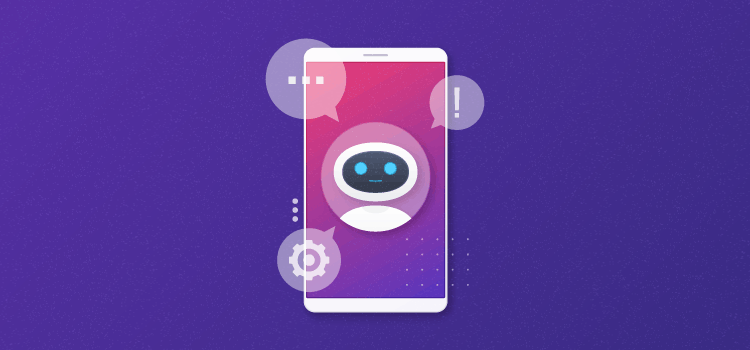AI Provides a Very Human Touch to the Higher Education User Experience
Former Tambellini Author

Artificial intelligence (AI) is attracting a lot of interest within higher education, so The Tambellini Group has a series of AI-related reports, vendor profiles, case studies, podcasts, and functional comparison infographics scheduled for 2019. AI assistants and chatbots are two areas within AI that you are probably hearing more about. Chances are you have interacted with one or the other, possibly without realizing it. If you are familiar with these terms, you may have noticed that they are often used interchangeably. However, there are key differentiators between these technologies that can help define which is the best fit for a specific use case.
Chatbots and AI Assistants in Higher Education
Chatbots and AI assistants are being deployed with a keen focus on improving the user experience by incorporating automation into daily tasks, and the use of these technologies is gaining momentum across higher education. Institutions are deploying and evaluating the use of chatbots and AI assistants to improve services to constituents in a number of ways. First and foremost, institutions are turning to AI technologies to provide immediate responses to prospect and student questions and to disseminate information associated with recruitment, admissions, registration, academics, student affairs, student success, alumni services, and career services. One of the most well-known AI assistants within higher education is Jill Watson, an IBM Watson-based application created by Professor Ashok Goel at the Georgia Institute of Technology. It was designed as a teaching assistant to respond to student questions in an online class forum. During its initial release, Jill Watson was so compelling, many students were not even aware that they were interacting with an AI teaching assistant. Likewise, Florida International University recently announced a partnership with Cognii, which specializes in AI virtual learning assistants and AI tutors, to provide immediate and personalized feedback to students, as well as to assist with grading and to provide analytics to professors that will enable them to tailor lectures and class material.
Georgia State University is using an AdmitHub AI assistant to assist students through the enrollment process. Using AdmitHub, students can send text messages with recruiting and admissions questions, and the AdmitHub AI assistant is able to handle a majority of the questions, augmented by human intervention as needed. This improves the user experience and reduces staff workload. The University of Alabama at Birmingham is also working to deploy a chatbot that can answer admissions-related questions, as well as allow current students to perform tasks such as accessing their course schedules and view account balances. Lastly, Saint Louis University has deployed Amazon’s Alexa inside campus dormitories and apartments, pre-programmed with responses to common questions, such as, “What time does the cafeteria close?” and, “Where is the financial aid office?”
Chatbot Versus AI Assistants
While chatbots and AI assistants have several similarities—they are both AI-based technologies that can respond to questions and automate tasks—they are also quite different in terms of the level of engagement and complexity that they can support. Some of the commonly known chatbots and AI assistants include Alexa (Amazon), Cortana (Microsoft), Google Assistant, and Siri (Apple). As institutions look at deploying these technologies, it is important to understand the differences between chatbots and AI assistants in order to select the technology that best meets the institution’s needs.
Chatbots
Chatbots are AI-based applications that understand natural language voice commands and conduct conversations using auditory and textual interactions. Chatbots are automated or pre-programmed interfaces that can be deployed via website, voice, and text, as well as over messaging platforms such as Facebook Messenger, Skype, and Webchat. Chatbots excel in automating simple tasks and are as intelligent as their underlying technology. For example, a chatbot can be used to greet a new prospect to an institution’s website and ask the prospect what they are interested in. It can then send details about the math program, for example, the prospect inquired about. However, chatbots tend to be more limited than virtual assistants in what they can assist with, remember, and process, for two key reasons. One is that the natural language processing (NLP) used by chatbots is not as advanced as the NLP used by AI assistants. Most chatbots leverage open-source NLP that is not customized to a brand’s industry. Secondly, since chatbots tend to lack an advanced dialog management engine, they are not able to maintain context in a conversation and cannot understand a constituent’s intent. Chatbots rely more on structured dialog conversation flows that are controlled by the chatbot, and the flows can break when the chatbot cannot understand the constituent’s intent.
AI Assistants
AI assistants, also known as virtual assistants and digital assistants, are AI-based applications that understand natural language voice commands and can perform tasks and assist in business transactions. AI assistants tend to be more interactive and sophisticated than chatbots and allow for human interaction that can assist with more challenging tasks. Unlike chatbots, which are programmed to pick up on certain keywords and provide specific responses, AI assistants can comprehend the meaning of what a human is saying. This is due to the fact that AI assistants leverage more advanced NLP that allows them to pick up on slang (rather than only a specific list of programmed terminology) and gain an understanding of the human’s intent. AI assistants can also continuously learn from each interaction and adjust as needed to improve the user experience. Another unique feature of AI assistants is their ability to use dynamic dialogue, where the flow of a conversation can switch between being controlled by the technology and the human.
Another key difference between AI assistants and chatbots is that AI assistants are able to persist a conversation and maintain consistency across multiple channels. For example, a student can start a conversation on an institution’s website and then continue the conversation via email or text messaging. Chatbots do not have the capability to maintain consistency across channels. With chatbots, students must start of new conversation when switching from website to email or text.
Leading AI Vendors in Higher Education
Many established higher education companies, such as Amazon, Campus Management, Google, IBM, Microsoft, Salesforce, and Oracle, are utilizing chatbots and AI assistants within their solution sets. In addition, there are also a number of best-in-breed companies that offer products that institutions are using to deploy chatbot and AI assistant applications. The following is a sample of AI companies that have a footprint within higher education.
Over the next few months Tambellini will be providing more detailed information on AI and AI-related vendor solutions.
In conclusion, AI technology is in its infancy and continues to evolve at a rapid pace. As a result, AI components, such as chatbots and AI assistants, are becoming more sophisticated and are able to support greater levels of complexity, and the types of use cases are expanding. In Tambellini’s recent Top of Mind Podcast, “University Leads Change Through Artificial Intelligence and Chatbots,” Curtis Carver, from the University of Alabama at Birmingham, suggests that in the future, AI will be just as mainstream as learning management systems are today. While there are definite similarities among chatbots and AI assistants, there are also some key differences that are important to
©Copyright 2019, The Tambellini Group. All Rights Reserved.
Categories
Share Article:

Other Posts From this Author:
© Copyright 2025, The Tambellini Group. All Rights Reserved.